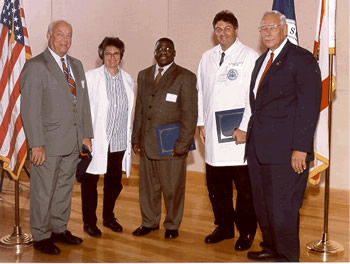Effect of Laser Radiation (Er,Cr:YSGG and GaAs) on Cariogenic Bacteria and Gingival Cells Through Photosensitization: A First Step Towards the Development of an Innovative Technique to Prevent Dental Caries
Grant Winners
- Denise Vedrenne, D.D.S. – College of Dental Medicine
- Howard Hada, Ph.D. – College of Medical Sciences
- Paul Bradley, M.D. – College of Dental Medicine
- Akintade Dare, D.D.S. – College of Dental Medicine
- Cesar Migliorati, D.D.S. – College of Dental Medicine
- Lisa Ameer – College of Dental Medicine, Dental Student
Deans
- Robert Uchin – College of Dental Medicine
- Harold Laubach – College of Medical Sciences
Abstract

Background: The College of Dental Medicine has acquired two types of laser devices to perform a variety of clinical procedures. These lasers will be used in this study to take the first step towards the development of an innovative technique to prevent dental caries. Photodynamic therapy is based on the concept that a photoactivatable compound, or Photosensitizer (PS), can be preferentially localized in certain tissues and subsequently activated by light of the appropriate wavelength to generate singlet oxygen and free radicals that are cytotoxic to cells and bacteria. The main problem is devising a strategy to target the PS to the bacteria while leaving the host gingival tissue unharmed.
Purpose: a) To evaluate the effect of laser radiation with photosensitizers on known cariogenic bacteria, b) evaluate the effect of laser radiation with photosensitizers on cariogenic plaque developed on human teeth, and c) develop a strategy to target the PS to the cariogenic plaque while leaving the gingival cells unharmed.
Methodology: The laser/photosensitizer combinations Er.Cr:YSGG/TBO and GaAs/ADP will be applied to cariogenic bacteria, cariogenic plaque and gingival fibroblasts, epithelial and endothelial cells, plus three control groups: (1) suspension fluid without TBO or ADP, not irradiated, (2) suspension(s) fluid without TBO or ADP, irradiated for different periods, and (3) suspension fluid with TBO or ADP, not irradiated. The number of viable bacteria will be calculated from colony forming units. The number of viable gingival cells will be calculated by cell proliferation and cytotoxicity assays. ANOVA tests will be used to determine statistical significance.
Significance: Utilization of safe laser protocols in clinical preventive dentistry (unattainable with traditional methods), for decontamination of tooth surfaces prior to sealant or restoration and for periodic inactivation of cariogenic biofilms to prevent caries in pregnant mothers, infants, special needs patients and underserved populations.